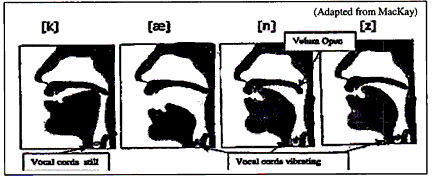Two Notation Systems for Signed Languages: Stokoe Notation & Sutton SignWriting Joe Martin Western Washington University Martinj4@cc.wwu.edu |
||||||||||||
|
STRUCTURE continued... Four Dimensions
Each alphabetic letter then, stands for a certain sequence of movement in 3D space. Each schematic shows the beginning or end of that sequence, so that taken together they indicate the sequence of movement. A third alternative would be to draw arrows with the picture; as do both SN and SSW. All three of these methods successfully represent three-dimensional language on a two dimensional surface, and we have seen how linear ordering adds the fourth dimension. Another issue is that non-spoken languages often use two sets of articulators at once, as in signing different things with each hand. How to represent this in the linear manner we are accustomed to has been called an insurmountable problem, necessitating awkward multiple lines of script (Miller 199). For SN this may be true, but SSW solves the problem by using a "line" that sees not just one hand but the entire body, thus viewing all the articulators simultaneously. |
||||||||||||
|
|
